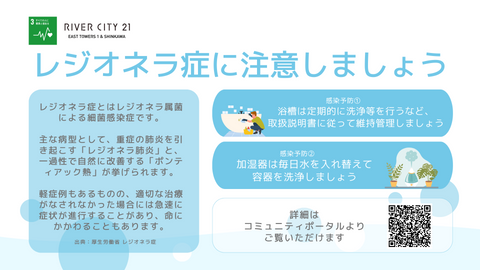Be careful of Legionnaires' disease
More information about Legionnaires' disease can be found on the Ministry of Health, Labor and Welfare's website.
Link: https://www.mhlw.go.jp/stf/newpage_00393.html#Q5
Q.1: What is Legionnaires' disease?
Legionnaires' disease is a bacterial infection caused by bacteria of the genus Legionella, represented by Legionella pneumophila. The two main types of illness are known as ``Legionella pneumonia,'' which causes severe pneumonia, and ``Pontiac fever,'' which is a temporary disease that improves spontaneously. Legionnaires' disease was named legionnaires' disease after it was discovered in 1976 as a mass pneumonia at a Legion gathering in Philadelphia, USA. Pontiac fever, on the other hand, was named after an outbreak that occurred in Pontiac, Michigan, in 1968.
Q.2: What is Legionella?
Legionella bacteria are bacteria that live in nature (rivers, lakes, hot springs, soil, etc.) and can cause Legionnaires' disease if infected. Approximately 60 types of Legionella bacteria are known to date, and among these, Legionella pneumophila is considered to be one of the representative Legionella bacteria that causes Legionella pneumonia.
Q.3: What are the symptoms of Legionnaires' disease?
The incubation period for Legionnaires' disease (the period from infection until symptoms appear) is 2 to 10 days. The main types of Legionnaires' disease are known as severe Legionnaires' pneumonia and mild Pontiac fever.
Symptoms of Legionella pneumonia begin with general malaise, headache, loss of appetite, and muscle pain, followed by cough, high fever of 38°C or higher, chills, chest pain, and difficulty breathing. Although rare, extrapulmonary symptoms, such as myocarditis, may occur. In addition, symptoms of central nervous system neuropathy such as decreased level of consciousness, hallucinations, trembling of the limbs, and diarrhea are also considered to be characteristics of Legionnaires' pneumonia. Although some cases are mild, if proper treatment is not given, the symptoms can progress rapidly and can be life-threatening.
In contrast, Pontiac fever causes symptoms such as sudden fever, chills, and muscle pain, but these symptoms are temporary and resolve on their own.
Q.4: How is Legionella transmitted?
Legionnaires' disease is primarily caused by bacterial infection through inhalation of aerosols (fine mist or droplets) contaminated with Legionella bacteria. Legionella bacteria cannot be transmitted from person to person.
1. Aerosol infection Infection is caused by inhaling aerosols contaminated with Legionella bacteria. Typical aerosol infection sources have been reported to include cooling tower water, humidifiers, and circulating bathtubs.
2. Inhalation/Aspiration In addition to aerosol infection, cases of infection have been reported from inhalation/aspiration of contaminated water from drowning in hot spring baths or rivers.
3. Infection from soil Cases of infection have been reported that are thought to be caused by inhaling dust from leaf mold contaminated with Legionella bacteria.
Q.5: What should I do to prevent infection from humidifiers, etc.?
When using a humidifier such as an ultrasonic vibrator, change the water and clean the container every day. Since Legionella bacteria are sterilized in 5 minutes at 60°C, humidifiers that heat water and generate steam are unlikely to be a source of infection.
In addition, if you have a circulation type bathtub (a bath with a reheating function, a 24-hour bath, etc.), in order to prevent Legionnaires' disease, there should be no dirt or biofilm (biological film. "Slimy" formed by bacteria) in the bathtub. ) Please maintain and manage the product according to the instruction manual, such as cleaning it regularly to prevent it from occurring. It is important to remove dirt and slime to eliminate an environment where Legionella bacteria can easily grow.
Q.6: What is the treatment for Legionnaires' disease?
Legionella pneumonia is a bacterial infection caused by Legionella bacteria, so it can be treated with antibiotics such as macrolides, new quinolones, and rifampicin. Early diagnosis and early treatment are important.
Pontiac fever, on the other hand, often resolves on its own and improves within a few days without antibiotics.
Q.7: Is there a vaccine against Legionella bacteria?
Currently, there is no vaccine that can prevent it.
Q.8: What is the incidence of Legionnaires' disease?
According to a report by the National Institute of Infectious Diseases, domestic cases occur year-round, but are particularly common in July and September, and are sometimes associated with bathing in hot springs or travel. In addition, reports of Legionnaires' disease infected not only domestically but also while traveling abroad have been increasing, and in the past 10 years, there have been many cases where infection is suspected to have occurred in countries such as China, South Korea, Turkey, Italy, and Taiwan.
Q.9: What is the number of patients with Legionnaires' disease in Japan?
With the enforcement of the Infectious Disease Law in 1999, all cases of Legionnaires' disease are now to be reported to prefectures. The number of reported cases of Legionnaires' disease since 1999 is shown in the figure.
With the development and spread of testing methods in recent years, the number of cases reported has been on the rise.
Q.10: Who is at high risk for Legionella infection?
Elderly people and newborns are at higher risk of developing pneumonia, so care should be taken. Heavy drinkers, smokers, dialysis patients, transplant patients, and people with weakened immune systems are also said to be at higher risk of developing Legionnaires' pneumonia.
Q.11: How is Legionnaires' disease diagnosed?
At medical institutions, tests can be performed using culture, urinary Legionella antigen testing, genetic testing (LAMP method), and blood antibody testing. Legionnaires' disease is diagnosed if either test is positive.
However, the urinary Legionella antigen test, which detects some of the Legionella bacteria in the urine (Legionella antigen), may give a positive result if you have been infected in the past. Therefore, a positive test result does not necessarily indicate current Legionella infection.
Source: Ministry of Health, Labor and Welfare Legionnaires' disease
Did you read the content of this article?

Be careful of Legionnaires' disease
More information about Legionnaires' disease can be found on the Ministry of Health, Labor and Welfare's website.
Link: https://www.mhlw.go.jp/stf/newpage_00393.html#Q5
Q.1: What is Legionnaires' disease?
Legionnaires' disease is a bacterial infection caused by bacteria of the genus Legionella, represented by Legionella pneumophila. The two main types of illness are known as ``Legionella pneumonia,'' which causes severe pneumonia, and ``Pontiac fever,'' which is a temporary disease that improves spontaneously. Legionnaires' disease was named legionnaires' disease after it was discovered in 1976 as a mass pneumonia at a Legion gathering in Philadelphia, USA. Pontiac fever, on the other hand, was named after an outbreak that occurred in Pontiac, Michigan, in 1968.
Q.2: What is Legionella?
Legionella bacteria are bacteria that live in nature (rivers, lakes, hot springs, soil, etc.) and can cause Legionnaires' disease if infected. Approximately 60 types of Legionella bacteria are known to date, and among these, Legionella pneumophila is considered to be one of the representative Legionella bacteria that causes Legionella pneumonia.
Q.3: What are the symptoms of Legionnaires' disease?
The incubation period for Legionnaires' disease (the period from infection until symptoms appear) is 2 to 10 days. The main types of Legionnaires' disease are known as severe Legionnaires' pneumonia and mild Pontiac fever.
Symptoms of Legionella pneumonia begin with general malaise, headache, loss of appetite, and muscle pain, followed by cough, high fever of 38°C or higher, chills, chest pain, and difficulty breathing. Although rare, extrapulmonary symptoms, such as myocarditis, may occur. In addition, symptoms of central nervous system neuropathy such as decreased level of consciousness, hallucinations, trembling of the limbs, and diarrhea are also considered to be characteristics of Legionnaires' pneumonia. Although some cases are mild, if proper treatment is not given, the symptoms can progress rapidly and can be life-threatening.
In contrast, Pontiac fever causes symptoms such as sudden fever, chills, and muscle pain, but these symptoms are temporary and resolve on their own.
Q.4: How is Legionella transmitted?
Legionnaires' disease is primarily caused by bacterial infection through inhalation of aerosols (fine mist or droplets) contaminated with Legionella bacteria. Legionella bacteria cannot be transmitted from person to person.
1. Aerosol infection Infection is caused by inhaling aerosols contaminated with Legionella bacteria. Typical aerosol infection sources have been reported to include cooling tower water, humidifiers, and circulating bathtubs.
2. Inhalation/Aspiration In addition to aerosol infection, cases of infection have been reported from inhalation/aspiration of contaminated water from drowning in hot spring baths or rivers.
3. Infection from soil Cases of infection have been reported that are thought to be caused by inhaling dust from leaf mold contaminated with Legionella bacteria.
Q.5: What should I do to prevent infection from humidifiers, etc.?
When using a humidifier such as an ultrasonic vibrator, change the water and clean the container every day. Since Legionella bacteria are sterilized in 5 minutes at 60°C, humidifiers that heat water and generate steam are unlikely to be a source of infection.
In addition, if you have a circulation type bathtub (a bath with a reheating function, a 24-hour bath, etc.), in order to prevent Legionnaires' disease, there should be no dirt or biofilm (biological film. "Slimy" formed by bacteria) in the bathtub. ) Please maintain and manage the product according to the instruction manual, such as cleaning it regularly to prevent it from occurring. It is important to remove dirt and slime to eliminate an environment where Legionella bacteria can easily grow.
Q.6: What is the treatment for Legionnaires' disease?
Legionella pneumonia is a bacterial infection caused by Legionella bacteria, so it can be treated with antibiotics such as macrolides, new quinolones, and rifampicin. Early diagnosis and early treatment are important.
Pontiac fever, on the other hand, often resolves on its own and improves within a few days without antibiotics.
Q.7: Is there a vaccine against Legionella bacteria?
Currently, there is no vaccine that can prevent it.
Q.8: What is the incidence of Legionnaires' disease?
According to a report by the National Institute of Infectious Diseases, domestic cases occur year-round, but are particularly common in July and September, and are sometimes associated with bathing in hot springs or travel. In addition, reports of Legionnaires' disease infected not only domestically but also while traveling abroad have been increasing, and in the past 10 years, there have been many cases where infection is suspected to have occurred in countries such as China, South Korea, Turkey, Italy, and Taiwan.
Q.9: What is the number of patients with Legionnaires' disease in Japan?
With the enforcement of the Infectious Disease Law in 1999, all cases of Legionnaires' disease are now to be reported to prefectures. The number of reported cases of Legionnaires' disease since 1999 is shown in the figure.
With the development and spread of testing methods in recent years, the number of cases reported has been on the rise.
Q.10: Who is at high risk for Legionella infection?
Elderly people and newborns are at higher risk of developing pneumonia, so care should be taken. Heavy drinkers, smokers, dialysis patients, transplant patients, and people with weakened immune systems are also said to be at higher risk of developing Legionnaires' pneumonia.
Q.11: How is Legionnaires' disease diagnosed?
At medical institutions, tests can be performed using culture, urinary Legionella antigen testing, genetic testing (LAMP method), and blood antibody testing. Legionnaires' disease is diagnosed if either test is positive.
However, the urinary Legionella antigen test, which detects some of the Legionella bacteria in the urine (Legionella antigen), may give a positive result if you have been infected in the past. Therefore, a positive test result does not necessarily indicate current Legionella infection.
Source: Ministry of Health, Labor and Welfare Legionnaires' disease
Environment
Initiatives to reduce environmental impact
Social
Contributing to society and the community
Governance
Collaboration with stakeholders
SDGs activities
support
Terms and security
ESG portal site
This website is a community portal that creates opportunities for collaboration and communication with residents in order to realize a sustainable society and community.

